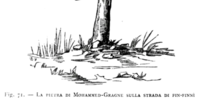@Shimbiris see how the late medieval Abyssinians (Habash) considered the camel a regular food among the Muslims for meat, of which we know only Somalis had the camel population to eat that normally. We're shown repeatedly through all relevant indicators that the general Islamic region in the medieval days was inhabited by Somalis.
Thomas Guindeuil, "What do Christians (Not) Eat: Food Taboos and the Ethiopian Christian Communities (13th-18th c.)"(2014): p. 66
Pay attention to how the source said neighboring communities. It means even in the far the Somali periphery, showing that Somalis had a presence deep into Ethiopia, so far that on the margins camel meat was very accessible. It shows one important thing if we are to do a serious analysis.
The Muslims that live in those Habash areas today do not eat camel meat:
View attachment 320193
Éloi Ficquet, "Flesh Soaked In Faith," (2006): p. 45
Lij Iyasu, the emperor of Ethiopia, slaughtered a camel to forge some form of political situation between Muslims. Notably, the camel was chosen for the Muslims. To the Christian Ethiopians, its original ethnic association changed toward a purely religious one, when in fact there is nothing in Islam that is generally camel emphasizing in meat consumption compared to cow, goat, and sheep.
View attachment 320194
Éloi Ficquet, "Flesh Soaked In Faith," (2006): p. 53
Notice the false association between the camel and how important it is for Muslims when it is a tradition of perception by the Christians because of the ethnoreligious association of Somali camel eaters. In their logic from the medieval age: Somalis ate camels --> Somalis were Muslims and the predominant demographic --> thus camel important Muslim diet.
Later they falsely as you see above with an emperor trying to form ties with Muslims by slaughtering a camel for symbolism. I wanted to correct the whole thing but either way, this is important evidence of how even down to the modern era, non-Muslims in the region carried a tradition of their own thinking that camel was an important Islamic meat when it was merely important for Somalis.
The dromedary is the emblematic animal of the lowlands, as he can carry heavy loads (up to 300 kg) over long distances, and can resist high temperatures and lack of water. Dromedary breeding is usually done in association with small livestock (goats or sheep), both of which tolerate full nomadism, unlike cattle which do not. Samantha Kelly, "A Companion to Medieval Ethiopia and Eritrea" (2020): p. 401-2
But lowland pastoralists were of course not the only medieval Ethiopians to tend livestock: highland farmers did as well. The zebu, originally from India and domesticated in antiquity, was a key element of the crop-livestock production system, as a work animal and for its dung that served as fuel and manure. Though poor in milk production, it was also raised for its meat, and the hide was made into leather. Smaller livestock like sheep and goats were also raised for their meat and hides. Sheepskin was often worn as a mantle, while goatskin was the favored material for parchment. Horses and donkeys were used for riding and as load animals. Samantha Kelly, "A Companion to Medieval Ethiopia and Eritrea" (2020): p. 402
Muslim Ethiopians, of course, observed their own food customs, regulations, and rituals, which reinforced the distinctions between these peoples. Dromedary meat, for instance, was eaten exclusively by Muslims: in the early fourteenth century, Ibn Baṭṭūṭa mentioned the massive slaughtering of dromedaries in Zäylaʿ for meat consumption. The Lives of medieval Ethiopian saints also record that captured Christians were urged (and refused) to eat dromedary, as its consumption was understood as synonymous with Muslim identity. Even where meats acceptable to both religions were concerned, the rituals of slaughtering differed, which effectively prevented any commensality between Muslims and Christians as soon as meat was included in the meal. Samantha Kelly, "A Companion to Medieval Ethiopia and Eritrea" (2020): p. 405




